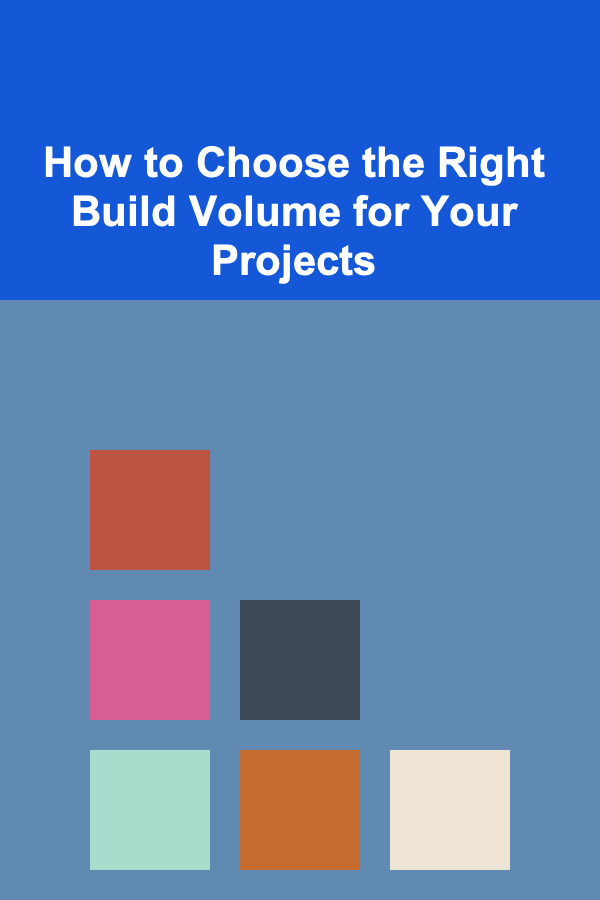
How to Choose the Right Build Volume for Your Projects
ebook include PDF & Audio bundle (Micro Guide)
$12.99$7.99
Limited Time Offer! Order within the next:

When it comes to 3D printing, one of the first decisions to make is selecting the appropriate build volume for your projects. The build volume refers to the maximum space available on a 3D printer where the object can be printed. It is one of the key specifications that affects the scope of what you can create. Getting the right build volume is crucial, as it can determine the efficiency of your workflow, the types of projects you can work on, and even the costs involved. In this article, we will dive deep into the factors that influence the decision of choosing the right build volume and how to assess your specific needs.
What Is Build Volume?
Build volume is essentially the largest size an object can be while being printed. This is determined by the three dimensions:
- Length (X-axis)
- Width (Y-axis)
- Height (Z-axis)
It is crucial to understand that the build volume is not just a number that indicates how big or small a printer is; it has direct implications on what you can and cannot print. The build volume also influences print quality, time, material usage, and even the post-processing steps.
Why Build Volume Matters
The size of the build volume you choose will significantly impact your projects in a variety of ways. Let's explore some of the most important aspects.
- Project Size: The most obvious reason to choose the right build volume is that it dictates the maximum size of the objects you can print. A larger build volume will allow you to print bigger objects, while a smaller build volume restricts you to smaller designs.
- Print Efficiency: If you consistently need to print larger objects but are limited by a small build volume, you will either need to scale down your designs or break them into smaller parts and reassemble them. This can increase the overall print time, complexity, and material usage.
- Material and Cost: Larger build volumes typically require more material, which increases costs. Additionally, printers with larger build volumes tend to be more expensive, not just in terms of purchase price but also in terms of maintenance and operational costs.
- Print Speed: While the size of the build volume does not directly affect the speed of printing, larger prints may take more time due to the increased amount of material and the complexity of the print. If you regularly need to print large, complex objects, you should be prepared for longer print times.
Factors to Consider When Choosing Build Volume
Now that we understand the importance of build volume, let's look at the key factors to consider when choosing the right size for your projects.
1. Nature of Your Projects
One of the first things to consider when selecting a build volume is the nature of the projects you plan to create. The type of objects you are printing will determine the size of the printer you need.
- Small Parts and Prototyping: If you are primarily working with small parts, such as miniatures, prototypes, or intricate models, a printer with a smaller build volume will suffice. Small build volumes can also be more affordable and faster for creating smaller objects.
- Large Parts and Functional Prototypes: If you are working with larger components, such as mechanical parts, or need to print full-size prototypes, then a printer with a larger build volume is essential. This is especially important if the part cannot be broken down into smaller sections due to its design or functionality.
- Customization Needs: If your work involves customized or one-off pieces, especially in industries like jewelry, dental, or fashion, where the items are typically smaller in size but highly detailed, then a medium-sized build volume may be sufficient.
2. The Type of Material Used
The type of material you plan to use will also influence the build volume choice. Different materials have unique characteristics that may require a certain amount of space to print effectively.
- Plastic-based Materials: Common materials like PLA, ABS, or PETG are widely used for most 3D printing applications. These materials usually do not require as much space, so medium-sized printers can easily handle them. However, if you are printing large objects or need higher structural integrity (e.g., for engineering applications), you may need a larger build volume.
- Resin-based Printing: Resin printing, such as SLA (Stereolithography) or DLP (Digital Light Processing), can produce highly detailed prints but is generally limited by the size of the printer. In this case, a printer with a large build volume may be essential for producing big, complex models.
- Metal and Other Industrial Materials: Industrial 3D printers that use metal or composite materials often require much larger build volumes. These printers are used for applications in aerospace, automotive, and manufacturing industries. If your work involves producing metal parts or other advanced materials, larger build volumes will allow you to create parts without the need for multiple smaller prints.
3. Available Space and Workflow
When selecting a build volume, the physical space where the 3D printer will be placed is important. Larger printers with bigger build volumes often require more space, both for the printer itself and for any post-processing or assembly steps.
- Work Area Size: If you are working in a small workshop, office, or home space, a large 3D printer may not be ideal. Smaller printers fit more easily in tight spaces, while larger ones may take up a significant portion of the room. The workflow surrounding your 3D printing process also affects how you manage the build volume. If you need to handle large parts post-print, such as with assembly or finishing, this should be factored into your decision.
- Convenience of Transport: Larger printers with larger build volumes are typically heavier and bulkier. Consider whether you need a printer that is portable or if it will remain stationary.
4. Printer Technology and Capabilities
Not all 3D printers are created equal, and the technology behind them can have a significant impact on your decision.
- FDM/FFF Printers: Fused Deposition Modeling (FDM) printers are the most common type and offer a wide range of build volumes. For most general-purpose applications, printers with build volumes around 200mm x 200mm x 200mm are ideal. However, if you are working on larger projects, you may need printers with build volumes up to 500mm or more.
- SLA/DLP Printers: These printers, which use resin-based materials, usually have smaller build volumes compared to FDM printers. If you are working with high-resolution, fine-detail prints, an SLA or DLP printer with a smaller build volume might be suitable.
- SLS Printers: Selective Laser Sintering (SLS) printers, used mainly for industrial applications, typically offer large build volumes due to the nature of their printing technology. These printers use lasers to sinter powdered materials, creating durable, high-performance parts.
- Large-Scale and Industrial Printers: If your work requires industrial-grade prints, you may need to consider large-scale printers, which can handle build volumes several meters in size. These are typically used in industries such as aerospace, automotive, and construction.
5. Future Growth and Flexibility
Another important aspect to consider is future-proofing your investment. Think about the types of projects you may want to take on in the future and whether the build volume of the printer you are considering can accommodate them.
- Scaling Up: If your business or project involves rapid growth, you may eventually need to scale up your production. Choosing a printer with a slightly larger build volume than you currently need can give you flexibility in the future without the need for constant upgrades.
- Versatility: Some 3D printers offer adjustable build volumes, or the ability to expand the printing area with modular components. This can be a great option if you anticipate needing larger prints down the road but want to keep costs down in the beginning.
6. Budget Constraints
Larger printers with bigger build volumes come at a higher cost, both for the initial purchase and for ongoing maintenance and material costs. It is important to balance your project needs with your available budget.
- Affordability: If you are just starting out or working on small projects, it is best to start with a printer that suits your current needs. Investing in a large-scale printer when it is not necessary could lead to increased costs that you may not be able to justify.
- Long-term Value: While large printers may seem like a bigger upfront cost, they can be more economical in the long term if you frequently need to print large parts. By avoiding the need for multiple smaller prints, a large build volume can save time and material, making it more cost-effective.
7. Community and Support
Choosing a printer with a larger build volume may also require more technical support. Larger printers can be more complex, and you may need to rely on the manufacturer for troubleshooting or technical issues.
- Technical Support: Ensure that the printer you choose comes with adequate technical support and resources. Printers with larger build volumes may require more calibration and maintenance, so you should factor in support services and community advice to help resolve issues.
- Community and Feedback: Look for community feedback regarding the performance and reliability of the printer, especially in relation to its build volume. A larger printer may have specific quirks that require attention, and it is always helpful to learn from the experiences of others.
Conclusion
Choosing the right build volume for your 3D printing projects is not a one-size-fits-all decision. It involves a careful assessment of the types of objects you plan to create, the materials you will use, your available space, and your budget. It also requires consideration of future growth and the ability to scale your projects as needed. By carefully evaluating these factors and understanding how the build volume affects your workflow, you can make an informed decision that will set you up for success. Whether you are working on small-scale prototypes or large industrial parts, the right build volume will ensure that you are equipped to handle your projects efficiently and effectively.
Other Products

How to Choose the Right Pet Toys for Mental and Physical Stimulation
Read More
How to Create a Checklist for Designing Mobile-Friendly Emails
Read More
How to Declutter Your Office Supply Cabinet
Read More
How to Invest in Rental Properties for Passive Income
Read More
How to Protect Your Home from Seasonal Weather Damage
Read More